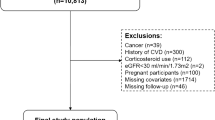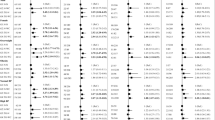Abstract
OBJECTIVE:
To investigate whether the association between the metabolic syndrome (MS) and cardiovascular disease (CVD) in obese adults is influenced by the criteria used to diagnose the MS.
DESIGN AND SUBJECTS:
Cross-sectional study in 389 obese adults (male/female: 26%/74%; body mass index (BMI): 30.1–63.2 kg/m2; age: 18–79 y).
MEASUREMENTS:
To diagnose the MS by the WHO or the ATPIII criteria, body mass index, waist circumference, fasting and 2-h oral Glucose tolerance test plasma glucose, fasting plasma triglycerides and HDL cholesterol, systolic and diastolic blood pressure, 24-h albumin excretion, and fasting insulin were measured. The association between the MS diagnosed with either definition and self-referred CVD was investigated.
RESULTS:
The prevalence of the MS by the WHO was higher than by the ATPIII criteria (WHO 69.1%, ATPIII 49.4%; P<0.001). The MS diagnosed by the WHO criteria was significantly associated with self-referred CVD (odds ratio (OR) 5.80, 95% CI 1.35–24.95, P<0.05), whereas the ATPIIII MS was not (OR 1.34, 95% CI 0.59–3.03). An elevated blood pressure (OR 5.04, 95% CI 1.41–18.01, P<0.05) and microalbuminuria (OR 2.61, 95% CI 1.06–6.40, P<0.05) were independently associated with CVD. Consideration of the OGTT data as part of the ATPIII MS definition improved its associations with CVD (OR 4.39, 95% CI 1.29–14.94, P<0.05).
CONCLUSION:
The WHO criteria appear to identify a greater number of obese adults at risk for CVD. Nevertheless, the addition of an OGTT at least in nondiabetic patients with two ATPIII-defined metabolic risk factors may help to improve the association between the MS and CVD in obese adults.
This is a preview of subscription content, access via your institution
Access options
Subscribe to this journal
Receive 12 print issues and online access
$259.00 per year
only $21.58 per issue
Buy this article
- Purchase on Springer Link
- Instant access to full article PDF
Prices may be subject to local taxes which are calculated during checkout

Similar content being viewed by others
References
Reaven GM . Banting lecture 1988. Role of insulin resistance in human disease. Diabetes 1988; 37: 1595–1607.
Lakka HM, Laaksonen DE, Lakka TA, Niskanen LK, Kumpusalo E, Tuomilehto J, Salonen JT . The metabolic syndrome and total and cardiovascular disease mortality in middle-aged men. JAMA 2002; 288: 2709–2716.
Ford ES . The metabolic syndrome and mortality from cardiovascular disease and all-causes: findings from the National Health and Nutrition Examination Survey II Mortality Study. Atherosclerosis 2004; 173: 309–314.
Hu G, Qiao Q, Tuomilehto J, Balkau B, Borch-Johnsen K, Pyorala K, DECODE Study Group. Prevalence of the metabolic syndrome and its relation to all-cause and cardiovascular mortality in nondiabetic European men and women. Arch Intern Med 2004; 164: 1066–1076.
Alberti K, Zimmet P, for a WHO Consultation. Diagnosis and classification of diabetes mellitus. Definition, diagnosis and classification of diabetes mellitus and its complications, part 1. World Health Organization: Geneva, Swizerland; 1999.
Executive summary of the third report of the National Cholesterol Education Program (NCEP) Expert Panel on detection, evaluation, and treatment of high blood cholesterol in adults (Adult Treatment Panel III). JAMA 2001; 285: 2486–2497.
Ford ES, Giles WH . A comparison of the prevalence of the metabolic syndrome using two proposed definitions. Diabetes Care 2003; 26: 575–581.
Marchesini G, Forlani G, Cerrelli F, Manini R, Natale S, Baraldi L, Ermini G, Savorani G, Zocchi D, Melchionda N . WHO and ATPIII proposals for the definition of the metabolic syndrome in patients with Type 2 diabetes. Diabet Med 2004; 21: 383–387.
Marchesini G, Melchionda N, Apolone G, Cuzzolaro M, Mannucci E, Corica F, Grossi E, QUOVADIS Study Group. The metabolic syndrome in treatment-seeking obese persons. Metabolism 2004; 53: 435–440.
Park YW, Zhu S, Palaniappan L, Heshka S, Carnethon MR, Heymsfield SB . The metabolic syndrome: prevalence and associated risk factor findings in the US population from the Third National Health and Nutrition Examination Survey, 1988–1994. Arch Intern Med 2003; 163: 427–436.
Palaniappan L, Carnethon MR, Wang Y, Hanley AJ, Fortmann SP, Haffner SM, Wagenknecht L . Predictors of the incident metabolic syndrome in adults: the Insulin Resistance Atherosclerosis Study. Diabetes Care 2004; 27: 788–793.
Calle EE, Thun MJ, Petrelli JM, Rodriguez C, Heath Jr CW . Body-mass index and mortality in a prospective cohort of U.S. adults. N Engl J Med 1999; 341: 1097–1105.
Kip KE, Marroquin OC, Kelley DE, Johnson BD, Kelsey SF, Shaw LJ, Rogers WJ, Reis SE . Clinical importance of obesity versus the metabolic syndrome in cardiovascular risk in women: a report from the Women's Ischemia Syndrome Evaluation (WISE) study. Circulation 2004; 109: 706–713.
World Health Organization. Preventing and managing the global epidemic. Report of a WHO consultation World Health Organization; Geneva, Switzerland; 2000.
Guidelines Subcommittee. 1999 World Health Organization-International Society of Hypertension guidelines for the management of hypertension. J Hypertens 1999; 17: 151–183.
Alberti K, Zimmet P . Definition, diagnosis and classification of diabetes mellitus and its complications. Part 1: diagnosis and classification of diabetes mellitus provisional report of a WHO consultation. Diabet Med 1998; 15: 539–553.
Matthews DR, Hosker JP, Rudenski AS, Naylor BA, Treacher DF, Turner RC . Homeostasis model assessment: insulin resistance and beta-cell function from fasting plasma glucose and insulin concentrations in man. Diabetologia 1985; 28: 412–419.
Solymoss BC, Bourassa MG, Campeau L, Sniderman A, Marcil M, Lesperance J, Levesque S, Varga S . of increasing metabolic syndrome score on atherosclerotic risk profile and coronary artery disease angiographic severity. Am J Cardiol 2004; 93: 159–164.
Landis JR, Koch GG . The measurement of observer agreement for categorical data. Biometrics 1977; 33: 159–174.
Grundy SM . Obesity, metabolic syndrome, and cardiovascular disease. J Clin Endocrinol Metab 2004; 89: 2595–2600.
Isomaa B, Almgren P, Tuomi T, Forsen B, Lahti K, Nissen M, Taskinen MR, Groop L . Cardiovascular morbidity and mortality associated with the metabolic syndrome. Diabetes Care 2001; 24: 683–689.
Anderson JL, Horne BD, Jones HU, Reyna SP, Carlquist JF, Bair TL, Pearson RR, Lappe DL, Muhlestein JB, Intermountain Heart Collaborative (IHC) Study. Which features of the metabolic syndrome predict the prevalence and clinical outcomes of angiographic coronary artery disease? Cardiology 2004; 101: 185–193.
Chobanian AV, Bakris GL, Black HR, Cushman WC, Green LA, Izzo Jr JL, Jones DW, Materson BJ, Oparil S, Wright Jr JT, Roccella EJ . Joint National Committee on Prevention, Detection, Evaluation, and Treatment of High Blood Pressure. National Heart, Lung, and Blood Institute; National High Blood Pressure Education Program Coordinating Committee. Seventh report of the Joint National Committee on prevention, detection, evaluation, and treatment of high blood pressure. Hypertension 2003; 42: 1206–1252.
Schillaci G, Pirro M, Vaudo G, Gemelli F, Marchesi S, Porcellati C, Mannarino E . Prognostic value of the metabolic syndrome in essential hypertension. J Am Coll Cardiol 2004; 43: 1817–1822.
Clark LT, Ferdinand KC, Flack JM, Gavin 3rd JR, Hall WD, Kumanyika SK, Reed JW, Saunders E, Valantine HA, Watson K, Wenger NK, Wright JT . Coronary heart disease in African Americans. Heart Dis 2001; 3: 97–108.
Stehouwer CD, Gall MA, Twisk JW, Knudsen E, Emeis JJ, Parving HH . Increased urinary albumin excretion, endothelial dysfunction, and chronic low-grade inflammation in type 2 diabetes: progressive, interrelated, and independently associated with risk of death. Diabetes 2002; 51: 1157–1165.
Lempiainen P, Mykkanen L, Pyorala K, Laakso M, Kuusisto J . Insulin resistance syndrome predicts coronary heart disease events in elderly nondiabetic men. Circulation 1999; 100: 123–128.
Liese AD, Hense HW, Doring A, Stieber J, Keil U . Microalbuminuria, central adiposity and hypertension in the non-diabetic urban population of the MONICA Augsburg survey 1994/95. J Hum Hypertens 2001; 15: 799–804.
Jager A, Kostense PJ, Ruhe HG, Heine RJ, Nijpels G, Dekker JM, Bouter LM, Stehouwer CD . Microalbuminuria and peripheral arterial disease are independent predictors of cardiovascular and all-cause mortality, especially among hypertensive subjects: five-year follow-up of the Hoorn Study. Arterioscler Thromb Vasc Biol 1999; 19: 617–624.
Resnick HE, Jones K, Ruotolo G, Jain AK, Henderson J, Lu W, Howard BV, Strong Heart Study. Insulin resistance, the metabolic syndrome, and risk of incident cardiovascular disease in nondiabetic american indians: the Strong Heart Study. Diabetes Care 2003; 26: 861–867.
Grundy SM, Hansen B, Smith Jr SC, Cleeman JI, Kahn RA, American Heart Association; National Heart, Lung, and Blood Institute; American Diabetes Association. Clinical management of metabolic syndrome: report of the American Heart Association/National Heart, Lung, and Blood Institute/American Diabetes Association conference on scientific issues related to management. Circulation 2004; 109: 551–556.
Pi-Sunyer X . A clinical view of the obesity problem. Science 2003; 299: 859–860.
Ceriello A . Impaired glucose tolerance and cardiovascular disease: the possible role of post-prandial hyperglycemia. Am Heart J 2004; 147: 803–807.
Ridker PM, Buring JE, Cook NR, Rifai N . C-reactive protein, the metabolic syndrome, and risk of incident cardiovascular events: an 8-year follow-up of 14 719 initially healthy American women. Circulation 2003; 107: 391–397.
Aronson D, Bartha P, Zinder O, Kerner A, Markiewicz W, Avizohar O, Brook GJ, Levy Y . Obesity is the major determinant of elevated C-reactive protein in subjects with the metabolic syndrome. Int J Obes Relat Metab Disord 2004; 28: 674–679.
Acknowledgements
We are very grateful to Leonor Sanchez for technical assistance. This work was supported by a grant from the FIS of the Instituto de Salud Carlos III, Red de Grupos RTGO (G03/028), Madrid, Spain.
Author information
Authors and Affiliations
Corresponding author
Rights and permissions
About this article
Cite this article
Vidal, J., Morínigo, R., Codoceo, V. et al. The importance of diagnostic criteria in the association between the metabolic syndrome and cardiovascular disease in obese subjects. Int J Obes 29, 668–674 (2005). https://doi.org/10.1038/sj.ijo.0802921
Received:
Revised:
Accepted:
Published:
Issue Date:
DOI: https://doi.org/10.1038/sj.ijo.0802921
Keywords
This article is cited by
-
Weight loss independently predicts urinary albumin excretion normalization in morbidly obese type 2 diabetic patients undergoing bariatric surgery
Surgical Endoscopy (2013)
-
Metabolic Effects of Bariatric Surgery in Insulin-Sensitive Morbidly Obese Subjects
Obesity Surgery (2013)
-
Weight loss is a major contributor to improved sexual function after bariatric surgery
Surgical Endoscopy (2013)
-
Vitamin D, PTH, and the Metabolic Syndrome in Severely Obese Subjects
Obesity Surgery (2008)
-
Type 2 Diabetes Mellitus and the Metabolic Syndrome Following Sleeve Gastrectomy in Severely Obese Subjects
Obesity Surgery (2008)



